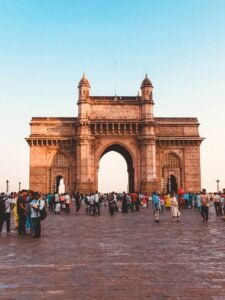The Gateway of India: A Majestic Arch-Monument in Mumbai

The Gateway of India is a magnificent arch-monument located on the waterfront of Mumbai, India. Completed in 1924, it stands as a symbol of historical significance and architectural grandeur. This iconic structure was erected to commemorate the momentous landing of George V, the Emperor of India, in December 1911 at Strand Road near Wellington Fountain. Notably, George V was the first British monarch to visit India.
The Gateway of India is not only a popular tourist attraction but also holds immense historical and cultural value. Let’s delve deeper into the fascinating history and architectural marvel of this iconic monument.
A Tribute to Royalty
The construction of the Gateway of India was commissioned to honor the visit of King George V and Queen Mary to Mumbai. Designed by the Scottish architect George Wittet, the monument was built in the Indo-Saracenic architectural style, which blends elements of Indian, Islamic, and European architecture.
Standing at a height of 26 meters (85 feet), the Gateway of India is adorned with intricate latticework, intricate carvings, and elegant domes. The yellow basalt stone used in its construction adds to its grandeur and gives it a regal appearance.
A Witness to History
Over the years, the Gateway of India has witnessed numerous significant events and historical milestones. It served as the ceremonial entrance for British viceroys and governors, witnessing their arrivals and departures. With the end of British rule in 1947, the monument took on a new role as a symbol of India’s independence.
Today, the Gateway of India stands as a reminder of Mumbai’s colonial past and its journey towards freedom. It has become an integral part of the city’s identity, attracting both locals and tourists from around the world.
A Popular Tourist Destination
The Gateway of India is a bustling hub of activity, with tourists flocking to marvel at its beauty and soak in its historical significance. The monument offers a stunning view of the Arabian Sea, making it a popular spot for photography and leisurely strolls.

Visitors can also take a boat ride from the Gateway of India to explore the nearby Elephanta Caves, a UNESCO World Heritage Site known for its ancient rock-cut temples. The monument is surrounded by various other attractions, including the Taj Mahal Palace Hotel, which adds to its allure.
A Symbol of Resilience
The Gateway of India has stood tall through the test of time, witnessing the city’s growth and transformation. It has become a symbol of resilience and unity, reflecting the spirit of Mumbai and its people.
Whether you’re a history enthusiast, an architecture lover, or simply a curious traveler, a visit to the Gateway of India is a must. It offers a glimpse into the rich heritage and cultural tapestry of Mumbai, leaving visitors in awe of its magnificence.
So, the next time you find yourself in Mumbai, make sure to pay a visit to this majestic arch-monument and experience the grandeur of the Gateway of India.